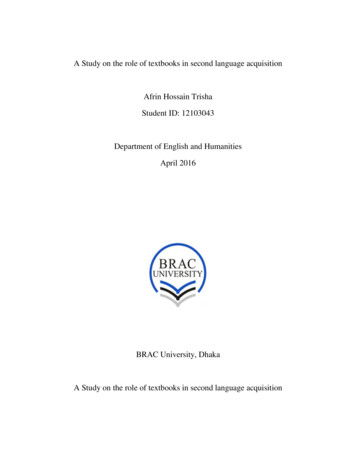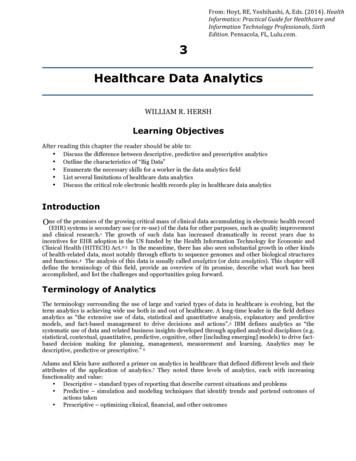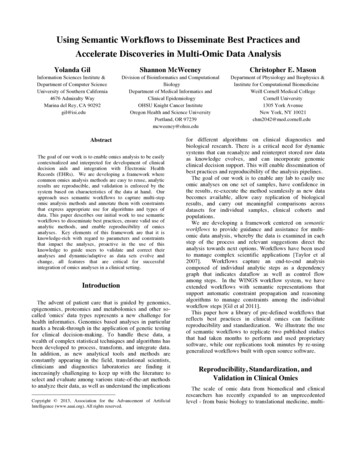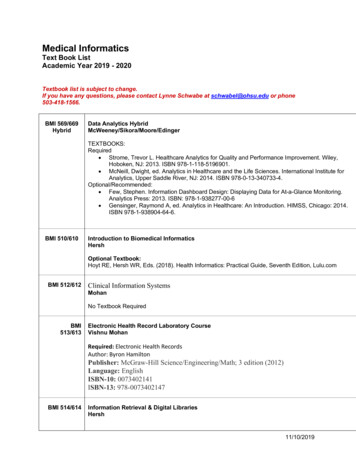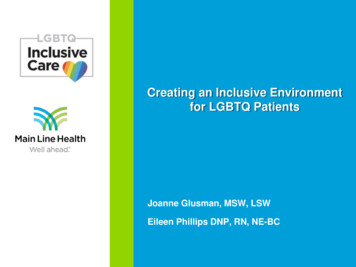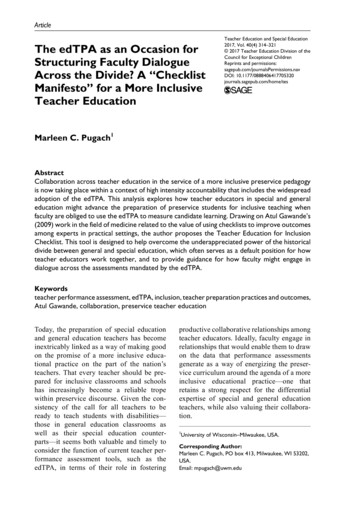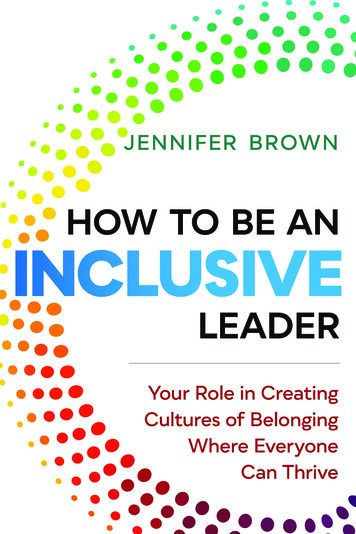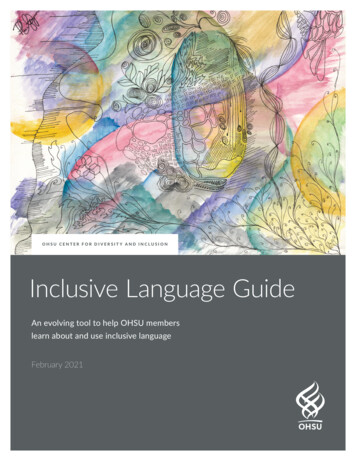
Transcription
OHSU CENTER FOR DIVERSITY AND INCLUSIONInclusive Language GuideAn evolving tool to help OHSU memberslearn about and use inclusive languageFebruary 2021
Inclusive language puts our humanity at the center; it allows everyone to feelrecognized, valued, invited and motivated to contribute at their highest level. Tobecome an anti-racist institution, OHSU must take concrete action to change ourculture and the experiences of OHSU members and stakeholders. If our wordsbut not our deeds change, we have failed. Yet learning about and using respectful,identity-affirming language is key to creating a welcoming environment that is antiracist and embraces diversity as a whole.Table of contentsPrinciples 4–7The OHSU Inclusive Language Guide is intended as an evolving tool to help OHSU members learn about anduse inclusive language in institutional communications, patient care (including chart notes), instruction andRace and ethnicity 8–13Immigration status and language proficiency 14–15Sex, gender, gender identity and sexual orientation 16–21Ability (physical, mental and chronological attributes) 22–25Glossary of terms and definitionsAppendix presentations around descriptors of: Race and ethnicity Immigration status Gender and sexual orientation Ability (including physical, mental and chronological attributes)This guide is a direct response to requests from many OHSU members in the wake of President Danny Jacobs’June 2020 proclamation that OHSU will work to dismantle systemic racism. Campus leaders in diversity, equity26–29and inclusion and in communications convened a six-person, diverse, cross-institutional Inclusive Language30–31The team surveyed the employee resource groups and other campus affinity groups, including students andProject Team. (See appendix)trainees, to make the case for and shape the guide’s content. In all, 272 OHSU members responded to the survey.They expressed strong agreement that a guide is needed to better focus and achieve the aspirations of respectfor all. Moreover, with their insights and feedback, the guide became a unique reflection of OHSU, its membersand what it means to a diverse range of individuals to feel seen and respected.“I love the idea of having an OHSU standard for how to identify race and ethnicity,” said one survey respondent.“It will make me feel better about my employment at OHSU to have this attention on respect and diversity.”It will take time to update language across platforms and software applications such as Epic and Oracle. Often,change related to gender and race will require conversations with vendors and the evolution of governmentdescriptors. In some instances, arriving at standard descriptors is not possible given the diversity of humanidentity and the imprecision and evolution of descriptors. But OHSU members have made clear that educationand guidance where possible is needed.
Principles Ask: When interacting with people for the first time, describe your intentionto use respectful language and ask, “How do wish for me to refer to you?”One survey respondent suggested, “When caring for a patient who is from aculture or group you are unfamiliar with, you must ask them how you canThe goal of using inclusive language is not transactional –it is not about getting it right or wrong as much as it isabout a paradigm shift.make them feel safe and respected.”Sharing how you wish to be addressed is one way to establish a dialogue in agroup setting: “Welcome to our class. I’m Dr. Neville. My pronouns are she/her/hers. I identify as Jamaican; it’s where my parents are from. I grew up in Seattle.I’d welcome knowing how each of you would like to be addressed or anythingLike the saying that history is written by the victors, discourse tends to bedominated by the majority point of view in any given situation. In general,discourse in American society has tended to center the experience of peoplewho are white, heterosexual and cisgender (their gender identity matches theirsex assigned at birth), setting this experience up at the norm and everythingelse as an exception or deviation. By contrast, acknowledging and affirmingdifference from the outset shifts to the premise of honoring and inviting multipleperspectives, and celebrating rather thanelse you would like us to know so that we can honor our diversity and refer toeach other respectfully. But what you choose to share now or in the future is upto you, and if you wish to share information privately with me, that’s also OK.I just want everyone to feel invited to be who they are in this class.” Be specific: We often hide behind vague words or generalizations when weare uncomfortable, such as using the word “diverse” to refer to people whoare not white and heterosexual. But this is incorrect. Diverse refers to two orsuppressing diversity.more people who are different from one another. Diverse is not defined as aThe intention of this guide is not to be prescriptive as much as instructive. Theare diverse.more we understand about language, descriptors and their meanings, the morewe can be intentional about how we speak and the impact of our words. Toperson or people who are different from you, as if you are the norm and theyIf referring to a wide spectrum of nonwhite people and specifying race isrelevant, you might say, “people of color and/or individuals who identify with acknowledging andother underrepresented groups” (if, in fact, they are underrepresented, suchaffirming differencethink about word choice:as in medicine or science). Or if you know the specific makeup of a group, youfrom the outset shifts tocould just be specific.the premise of honoring Identity is personal: Every individual has the right to describe themselves asAs one of the survey respondents said, “Since I have switched to saying whatdevelop this guide, we used insights from survey participants combined withscholarly and journalistic sources to offer the following principles to help youthey wish. One survey respondent said, “As a fat person, I’m offended by theI mean rather than hiding behind vague terms, I have been much moreword obese, as many fat people are. Many fat people reclaim the word ‘fat.’”effective in building relationships and making necessary points about howAmong people who fit the U.S. Census description of Hispanic (descendingto move forward in issues that surround race.” Another said, “Use clear,from a Spanish-speaking country), diversity — and the ways individualsunambiguous language.”and inviting multipleperspectives, andcelebrating rather thansuppressing diversity.describe themselves — is vast. This guide offers insight on general terms thatdoes not supersede how individuals choose to describe themselves. Be thoughtful and intentional: When is it even appropriate to call out a person’srace or physical or mental attributes? We recommend being thoughtful. In Respect: Not everyone wants to share their identity. If you are leading a groupa chart note, for example, one provider suggested including race and otheror setting the stage in a conversation, create space for people to show up assuch personal attributes in the social history but not in an introductorythey are to the extent that they wish to. A survey respondent said, “We need tostatement about a patient where such attributes can trigger bias. So ratherallow people at the individual level to choose whether they wish to disclosethan introducing the patient as a 25-year-old, Black woman, you would insteadtheir individual identities. Respect for privacy is important.”include her race in the social history because we know that a patient’s race is asocial determinant of health.4OHSU INCLUSIVE LANGUAGE GUIDE5
Be kind and affirming: Gender neutral language: “You guys,” or “ladies and gentleman,” can be “you– People-first language: We are all people with various attributes - a personwho lives with mental illness, a person who is gay or heterosexual. It isgenerally advised not to lead with the attribute, as if that attribute definesthe whole person – such as, a mentally ill person or an undocumentedperson. However, there are exceptions. Accepted terminology for individualsof transgender experience may include a transgender person, transgenderwoman or transgender man (the gender the person has transitionedto). “Identity-first” language leads with a defining attribute. In the Deafcommunity, for example, “Deaf person” is acceptable. People on the autismspectrum often call themselves autistic people. Always, when in doubt, askhow a person refers to themselves or, for general usage, use people-firstlanguage but be open to correction.It is generally advisednot to lead with theattribute, as if thatattribute defines thewhole person – suchas, a mentally illperson or anundocumented person.all” or “folks” or “welcome to all!” to include individuals who identify astransgender or nonbinary. This is equally important in other areas wheregendered language prevails. “Pregnant people or person,” for example, ratherthan “pregnant women or woman.” Other examples may include “parent(s)”instead of “mother(s) and father(s)” or “sibling” instead of “sister” or brother”or “chair” instead of “chairman.” In clinical realms, gender-neutral languagecan also be used when referring to anatomy or parts of the body. Capitalization: OHSU uses the Associated Press Style Guide on communicationsplatforms. The AP’s thoughtful attention to evolving language has inspiredcontinued confidence in this tool.– Black: In summer 2020, the AP began capitalizing Black in a racial, ethnic or– Avoid labels: Instead of “addict” use, “a person with a substance usedisorder.” Instead of labeling a patient “noncompliant” in a chart note, say“did not complete treatment” or “stopped taking medication.” When welabel people, it is as if that word wholly and forever defines them; it can alsotrigger biases in others. As people, our attributes can change over time. Aperson with a substance use disorder may simultaneously be a person inrecovery.cultural sense, conveying an essential and shared sense of history, identityand community among people who identify as Black, including those in theAfrican diaspora and within Africa. The lowercase black refers to the color,not a person.– Indigenous: Capitalized when referring to original inhabitants of a place.These two decisions align with long-standing capitalization of distinct racialand ethnic identifiers such as Latino, Asian American and Native American– Use asset- not deficit-based language: The goal is to focus on strengths. Hereare examples from the grant-writing world:or American Indian.– brown: The AP does not capitalize “brown” as in “brown people,” asit is a broad and imprecise term unless capitalized in a direct quote.ASSET BASEDDEFICIT BASEDOur mission is to amplify the voices inOur mission is to give voice toour community.the voiceless.Interpretations of what the term includes vary widely and many people find“brown people” offensive or demeaning.– white: The AP continues to lowercase the term white in racial, ethnic andcultural senses. The AP reasons that white people generally do not sharethe same history and culture, or the experience of being discriminatedThe communities we partner with areThe communities we serveagainst because of skin color. The AP agrees that white people’s skin colorstrong and powerful.are strong and powerful.plays into systemic injustices. But capitalizing the term, as is done by whitesupremacists, risks subtly conveying legitimacy to such beliefs. The APYouth in our community are our future.We provide youth with jobs in order toacknowledges that some view this decision as inconsistent or discriminatory.We must invest in them as leaders.prevent them from committing crimes.Others say capitalizing the term could pull white people more fully intodiscussions of race and equality. The AP plans to track how thought evolves Intellectual humility: Acknowledging that you understand the importance of,and periodically review the decision.and intend to use, respectful language shows and invites humility. At the sametime, avoid burdening others with your learning curve. So rather than, “I’mreally trying to use inclusive language, but sometimes I mess up, so cut mesome slack,” try, “I’m learning more about inclusive language and will try hardto get it right. Thank you for your patience.”6OHSU INCLUSIVE LANGUAGE GUIDE7
Race and ethnicityThe following is intended to educate about descriptorsof race and ethnicity to assist in choosing respectful andaffirming language when referring to individuals and groupsin a general sense:Broad terms referencing individuals/groupsBIPOC: Stands for Black, Indigenous and People of Color. Some individualsand groups have embraced this descriptor, while others feel alienated orunacknowledged by it. “People of color” is also widely used, but some point outThis guide recommends“Black, Indigenous,Hispanic, Asian andother people of color”as a broad term and theuse of more specificdescriptors when thoseare known or relevant.that white is also a color, don’t wish to be defined by their skin color or find thephrase othering. Others note that BIPOC centers race/ethnicity, not gender orother forms of diversity. In general, when desiring to refer broadly to racial orethnic groups other than white, non-Hispanic, this guide recommends “Black,Indigenous, Hispanic, Asian and other people of color” as a broad term and theuse of more specific descriptors when those are known or relevant.Underrepresented: The general phrase “underrepresented” or “members ofunderrepresented groups” is appropriate and is especially preferred when youcan be specific and accurate. For example: Black students and/or transgenderstudents are “underrepresented in medicine” or “underrepresented in dentistry.”An appropriate reference would be, “A goal of the scholarships is to provideUnderrepresented:financial support to students identifying with under-represented groups.” Note:The general phrase“underrepresented” Not all individuals of color are under-represented in the health professions.or “members ofIndividuals who identify as Asian (a large, diverse category) are notunderrepresentedunderrepresented in medicine, for example. This does not mean that theygroups” is appropriatedon’t experience racism or discrimination. And, several Asian subgroups, suchand is especiallyas Pacific Islander, are underrepresented in medicine.preferred when you canbe specific and accurate. The term “minority” (or “underrepresented minority”) centers people inthe majority, usually white people, and doesn’t account for the fact that insome groupings, “minorities” are in fact in the majority. (Some prefer theterm “minoritized,” to reflect the active subordination of a group of people;yet others feel that the term is insulting, implying a lack of agency amongindividuals to which it is applied.)8OHSU INCLUSIVE LANGUAGE GUIDE
A person or a descendant from the Middle East. The Middle Eastern countries are: Bahrain,S P E C I F I C T E R M S F O R S P E C I F I C G R O U P S ( S E E L AT I N O / H I S P A N I C O N P A G E S 1 2 –1 3 )Cyprus, Egypt, Iran, Iraq, Israel, Jordan, Kuwait, Lebanon, Northern Cyprus, Oman, Palestine,TERMDEFINITIONMiddle EasternerPakistan, are not included in the Middle East. These nations, as well as Algeria, Libya, Tunisia,and even Djibouti and Somalia, have been referred to as part of the Greater Middle East.“American Indian or Alaska Native” (AI/AN) includes all individuals who identify with anyof the original peoples of North America and who maintain tribal affiliation or communityattachment. Oregon has nine recognized tribes. Indigenous people use a range of wordsAmerican Indian or Alaska NativeNative Hawaiianto describe themselves and prefer various descriptors to be used by others. Some sayAmerican Indian or Native American, though both are white European constructs. MostPacific IslanderIndigenous people under Hispanic/Latino/Latinx.)referring to one of eight groups — Fijian, Guamanian, Hawaiian, Northern Mariana Islander,are Iranians who speak the Persian language (Farsi). The term Persian people historicallyLeague, 22 nations and territories formed in 1945. However, there are people who live inmeant “from Persis,” which is around Pars, Iran, north of the Persian Gulf. With thisArab countries who do not consider themselves Arabs, such as the Kurds.Arabian Peninsula. The Arabian Peninsula is now home to Arabic peoples, so you could saymajor sub-regions include Micronesia, Melanesia and Polynesia. A U.S. Census term,Persian can refer to people of Iran and a language. But, when referring to people, PersiansGenerally, and even more so presently, Arabs descend from member nations of the ArabArabs are also not necessarily Arabians. Arabians are people from the countries of thePolynesian people of the Hawaiian Islanders and/or their descendants.Palauan, Samoan, Tahitian, and Tonga Pilipino.Arab is an umbrella term for a pan-ethnic group of people, composed of many ethnicities.Arab and ArabianAn individual who is Native Hawaiian or is a descendant. They are the aboriginalAn individual who identifies or descends from the Pacific Islands or ancestry. The threeidentify with their specific nation, such as a member of the Navajo Nation. Respectful,general terms are Indigenous people or First People. Learn more. (See MesoamericanQatar, Saudi Arabia, Syria, Turkey, United Arab Emirates, and Yemen. Afghanistan anddefinition, not all Iranians are Persians, but all Persians are Iranians, nationally.PersianHowever, some now designate Persian people as a pan-ethnic group (like the Arab people).If unclear, describe someone from Iran as Iranian. Also, many Iranians use “Persian” tothat Arabians are Arabs, but not all Arabs are Arabians, since many live off of the peninsula.make a locational, rather than an ethnic, distinction. So there may be non-Persian peopleThe Arab peoples are united by an identity of a shared culture and history.(who don’t speak Farsi) whom Iranians deem Persian, as they come from the Persianregion. Learn more.Most Arabs speak Arabic, which is a language and not meant to refer to the people, thoughyou could say “Arabic-speaking people.” (See also Middle Easterner.)The Roma or Romani (also spelled Romany) are a traditionally itinerant ethnic group.AsianOregon has a large Roma community. They are often called Gypsies, but this is a termAn individual who identifies with one or more nationalities or ethnic groups originating inthe Far East, Southeast Asia or the Indian subcontinent.Roma, Romany, Romaniwith negative connotations of illegal activity, and many Roma do not identify with it.Romany (with a y) usually refers specifically to Romanichals, the native Romani subgroup inEngland. Learn more.The most inclusive term is Black people, denoting a shared sense of identity and experiencein this country related to skin color and not narrowing by the gender “men” or “women.”It is appropriate to use the phrase “a person from Russia” to refer to people (regardlessBlack people trace their origins to many countries, languages and ethnicities.of religion) who hail from this country. But coming from Russia can be different fromAfrican American is technically accurate for individuals and groups who identify asBlack/African Americanidentifying ethnically as Russian. Russia, like China, is home to many ethnicities, suchAmericans and trace their ancestry to Africa. Afro-Caribbean American denotes people whoidentify as Americans and trace their ancestry to both Africa and the Caribbean. CaribbeanAmerican denotes those who identify as American and solely with Caribbean ancestry.There are many other variations.An African is a person of African descent. Africans may be various races. Some do notRussians and Russian Old Believersas Chechan or Tatar. “He comes from Russia” is appropriate, but “he is Russian” may beinaccurate. A subset identifies as Russian Orthodox Old Believers (starovery). They aredescendants of medieval Russians who refused to adopt the mid-17th century churchreforms, viewing them as sacrilegious. Therefore, the Old Believers are also referred to asOld Ritualists (staroobryadtsy). Many Russian Old Believers live in Oregon. Learn more.identify with Black or African American culture.10OHSU INCLUSIVE LANGUAGE GUIDE11
Hispanic or Latino/Latina/LatinxHispanic, which includes descendants of all Spanish-speaking countries, or Latino/Latina/Latinx or Latino/Latinxreferring to people of Latin American heritage, are acceptable broad descriptors. The latter represents masculine(Latino), feminine (Latina) and nonbinary (Latinx). Learn more:T E R M S F O R H I S PA N I C O R L AT I N O/ L AT I N A / L AT I N X G R O U P STERMLatinoDEFINITIONGenerally refers to geography, namely from Latin America, which isLatino was recorded as early as the 1940s in the U.S. and ultimatelyany place in the Americas that speaks a language descending fromshortened from the Spanish Latinoamericano, or Latin American.a Latin romance language. Includes below the U.S., the CaribbeanThe U.S. Census introduced the term Latino in 2000 and the termand Brazil.Hispanic 20 years earlier.Describes a person who has lineage to a Spanish speakingHispanicHISTORYcountry, or whose heritage derives from it. It is not a prerequisiteto speak Spanish. Includes Spain but excludes Brazil wherePortuguese is spoken.C O M M E N TA R I E SHispanic and Latino can be viewed as interchangeable terms todescribe the ethnicity and heritage of a population that makes upnearly 20 percent of the United States population.Hispanic refers to Spain and its people on the Iberian Peninsula.During the Civil Rights Movement, there was a cry to recognizeHispanic derives from the Latin Hispānicus, the source of theU.S. Mexican, Puerto Rican and Cuban populations. The termname Spain. First recorded in English in the late 1500s. HispanicHispanic was adopted as a federal heritage category introduced inreflects the imperialist history of Spain as a European colonizerthe 1980 U.S. Census. The term caught on, with support of Spanish-in Latin America.language TV and became a more broadly accepted label.The Pew Research Center National Survey found that one in fourLatinxA term used to describe individuals who are of/or relate to LatinA new, gender-neutral, pan-ethnic label, Latinx, has emerged as anU.S. Hispanics/ Latinos have heard of Latinx but only 3 percentAmerican origin or descent. This term is a gender-neutral or non-alternative to describe Hispanics/Latinos. Latinx has been arounduse it. Some call it linguistic imperialism — English policing thebinary alternative to Latino or Latina. Listen to pronunciation.since 2004 but became better known after the 2016 Pulse nightclubSpanish language; Latinx does not correspond with Spanish grammarshooting in Orlando, Florida. This term tends to be used more byor conventional speech. The Real Academia Española, preserveryounger people and those identifying as LGBTQ.of the Spanish language, rejected the term. Merriam-Webster(Latine is also an emerging gender-neutral descriptor.)added it in 2018.Mexican American, Chicana, Cubano/a, Guatemalteca/o, PuertoPersonalismo – Personalization in Latino culture implies settingPersonalized – Individuals tend to identify or be influenced by theirMany first acknowledge their roots of origin prior to selectingRican, Dominican, Dominicano, Dominicana, Puertorriqueño, etc.trust to establish relationshipsorigin, roots, and/or heritage to Spain or a Latin American country.Hispanic or Latino. Soy Mexicana, Soy Otomi, Soy DomicanoThe Historical Linguistics of Native America notes more thanMesoamerican IndigenousA term used to describe Indigenous people from Mexico andCentral America.125 languages native to Mesoamerica. Language familiesSocieties that flourished more than 1,000 years before the Spanishinclude: Mesoamerica are Mayan, Mixe-Zoquean, Otomanguean,colonization of the Americas. Mesoamerican Indian/IndigenousTequistlatecan, Totonacan, Uto-Aztecan, and Xinkan. Not allcultures have a common origin in the pre-Columbian civilizations.speak Spanish.*The Spanish language also uses pronouns el, ella, ellos, nosotros and formal and informal language—tú y usted.12OHSU INCLUSIVE LANGUAGE GUIDE13
Immigration status and language proficiencyImmigration status:Rather than referring to residents who are not citizens with such dehumanizingterms as alien or illegal alien or simply illegal, the word “undocumented” isJust as American language has tended to center on thewhite experience, descriptors of immigration status tendto center on and affirm people with citizenship. They tendto dehumanize, criminalize and/or vilify those withoutcitizenship. This diverts attention from the circumstancesthat led them to leave their countries and from the barriersto legitimacy they’ve encountered in the U.S., and puts the“blame” solely on the individual or family. Inclusive languagearound immigration status affirms and acknowledges thelegitimacy of everyone as human beings:advised, ideally: The person or family is undocumented, not they are anundocumented family. Or, the person or family lacks documentation; or lacks a pathto citizenship.Language proficiency:She speaks English as a second language is viewed as inadequate in that peoplemay speak more than two languages. Emerging bilingual is equally limiting andEnglish language learner is paternalistic. Preferred: She speaks English in additionto other languages, or she speaks Spanish and is learning English, or Spanish orJapanese or Russian, etc. is her first language.GLOSSARY OF TERMSTERMU.S. citizensPermanent orconditional residentsDEFINITIONPeople who were born in the U.S. or who have become “naturalized” after being permanentresidents. Entitled to receive every benefit as other every U.S. citizen.Legal permanent residents (LPRs) are those who have a “green card.” A green card holder,or lawful permanent resident, has authorization to permanently live and work in the UnitedStates. Green card holders have all the benefits of U.S. citizenship except voting.People in this category are in the country legally but only on a temporary basis. Examples: Students (F-1 visa)Non-immigrants Business visitors or tourists (B1/B2 visas) Fiancées (K-1 visa) Individuals granted temporary protected statusPeople who are in the U.S. without permission are undocumented either because theyUndocumentedoverstayed a legal temporary visa or they entered the U.S. without going through a portof entry. They are not authorized to work or access public benefits. People who areundocumented risk being deported. This creates a highly stressful and unstable living situation.Full listing of terms for immigration glossary.15
Sex, gender, gender identity andsexual orientationSex is a label — most often male or female — that you’reassigned at birth based on your genitals and chromosomes.It goes on your birth certificate. Sex diversity also includesintersex. This is an umbrella term to describe people bornwith chromosomes, hormones and/or anatomy that is nottypically male or female. Intersex people can be any gender,including transgender or gender nonbinary.Gender is a social and legal status and a set of expectations from society aboutbehaviors, characteristics and thoughts. Each culture has standards about theway that people should behave based on their gender, also generally masculineand feminine.Gender identity is how you feel inside and how you express your gender throughyour clothing, behavior and personal appearance. It’s a feeling that begins veryearly in life.Sexual orientation is an inherent or immutable enduring emotional, romanticor sexual attraction to other people. Sexual orientation is not the same as, and isindependent of, gender identity.Broad referencesThe most inclusive general reference is LGBTQIA (lesbian, gay, bisexual,transgender, queer, intersex, asexual, and other sexual and gender minorities).LGBTQ is also widely used.16OHSU INCLUSIVE LANGUAGE GUIDE
GLOSSARY AND RESPECTFUL L ANGUAGE TIPSGender fluidS E X U A L O R I E N TAT I O NAsexualA person who does not experience sexual attraction.Lesbianmale and female roles and behavior. It doesn’t necessarily mean transgender. ForGender nonconformingexample, someone who was assigned male at birth and who identifies as male but whosegender expression does not fit traditional male roles may consider themselves gendernonconforming but not transgender.gender. Men, women and non-binary people may use this term to describe themselves.Genderqueerand non-binary people may use this term to describe themselves.Another term for gender nonconforming.This is an umbrella term to describe people born with chromosomes, hormones and/orIntersexGENDER IDENTITYanatomy that is not typically male or female. Intersex people can be any gender, includingtransgender or gender nonbinary.AFAB and AMABAcronyms for assigned female at birth and assigned male at birth.AgenderA general term to describe someone who has no gender.AllyA descriptive term for people whose gender identity or expression doesn’t fit traditionalA person who is emotionally, romantically or sexually attracted to members of the sameA woman who is emotionally, romantically or sexually attracted to other women. Womenfluid or neither. Transgender people’s gender identity is different from the gender they wereassigned at birth. Your gender identity may not be obvious to other people.gender identity though not necessarily simultaneously, in the same way or to the samedegree. Sometimes used interchangeably with pansexual.Gayother timeline.A person’s inner sense of their gender, whether it’s male, female, a combination of both,Gender identityA person emotionally, romantically or sexually attracted to more than one sex, gender orBisexualThis means having a gender identity that changes — long term, day to day or on anyAny non-LGBTQ person who helps or supports an LGBTQ person or t
“I love the idea of having an OHSU standard for how to identify race and ethnicity,” said one survey respondent. “It will make me feel better about my employment at OHSU to have this attention on respect and diversity.” It will take time to update language across platforms

